Psychology and Technology: A Premium Blend
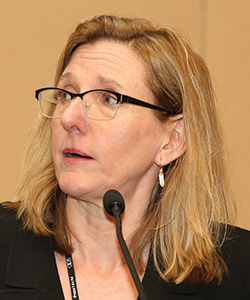
Kathleen M. Carroll has evaluated a self-guided web-based program that teaches a variety of cognitive behavioral skills for people trying to manage substance abuse problems.
Whether they’re conducting industrial/organization studies or analyzing brain scans, psychological scientists are proving to be anything but Luddites.
In “Advancing Psychological Science Through Technology,” a cross-cutting theme program at the 2016 APS Annual Convention in Chicago, a panel of researchers demonstrated how technology can be used to strengthen data collection, track brain activity, and test groundbreaking clinical interventions. Psychological and computer scientist Rainer Goebel, an APS Fellow who directs the Maastricht Brain Imaging Center at Maastricht University in the Netherlands, talked about the use of ultra-high-magnetic-field scanners, which enable researchers to see brain images in greater detail than do conventional fMRIs and allow data to be analyzed during a scan rather than after.
Goebel has been using this technology to test a form of neurofeedback. That work began when he studied Matthieu Ricard, a French writer and Buddhist monk, as he meditated during an fMRI scan. Goebel and his team found that Ricard, by thinking happy thoughts, could activate the area of his brain associated with pleasure and reward. From there, the researchers studied patients with recurrent treatment-resistant depression, showing them activity in the emotion networks of their brains in real time. Subsequent brain scans showed that the patients had developed the ability to effectively control those networks themselves.
“They learned something themselves in the private feedback session, which they can apply outside of the scanner once they’ve found the best strategies to do it,” Goebel explained.
Goebel and his team are now conducting clinical trials of this method and are observing similar results. And they’re even investigating the use of real-time brain imaging to help patients with impaired speech and motor control (e.g., people with ALS or Parkinson’s disease). He demonstrated the use of ultra-high-magnetic-field scanners to match brain activity with the letters of the alphabet, giving people who can no longer speak the potential to spell out words.
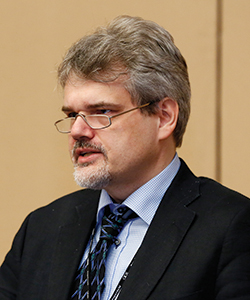
APS Fellow Rainer Goebel, who founded the Maastricht Brain Imaging Center in the Netherlands, has been using advanced brain-imaging technology to test a form of neurofeedback for patients dealing with recurrent depression and impaired speech and motor control.
Managing Addictions
Scientists are also finding technology a useful way to test interventions for behavioral problems, specifically drug and alcohol dependency. Kathleen M. Carroll, a Yale University psychological scientist who studies behavioral treatments, discussed her evaluations of Computer Based Training for Cognitive Behavioral Therapy (CBT4CBT) — a self-guided web-based program designed to aid in the treatment of substance abuse. The program teaches a variety of cognitive behavioral skills specifically aimed at helping people cope with cravings, strengthening their ability to decline offers of alcohol or drugs and increasing their awareness of thinking and decision-making patterns that can spur drug use.
In an 8-week randomized clinical trial of an outpatient community treatment program, Carroll and her colleagues looked at standard treatment (weekly individual and group therapy) — which the researchers referred to as “treatment as usual,” or TAU — versus CBT4CBT and TAU. CBT4CBT was offered in up to 2 weekly sessions, and both groups had a 6-month follow up.
After 8 weeks, 34% of the 77 participants who received CBT4CBT and TAU tested positive for drug use, whereas 53% of participants who received only TAU tested positive for drug use.
Potential uses of computer-assisted therapies include reaching patients in rural areas, increasing availability of early intervention and prevention for subclinical cases, and isolating effective components and mechanisms of treatment, Carroll said.
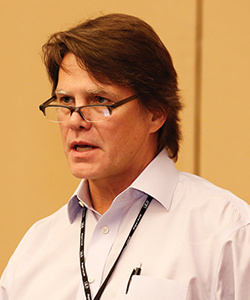
By having patients use electronic diaries to record their alcohol cravings and consumption, APS Fellow Timothy J. Trull and other researchers are striving to spot the environments and situations that fuel an individual’s substance abuse behaviors.
APS Fellow Timothy J. Trull (University of Missouri) also uses technology to study substance abuse problems, but his approach employs ambulatory
assessment of individuals in their natural environments.
“We’re focused on what people are really like when they’re ‘out in the wild,’” Trull said. “Are they like what they tell us they’re like? What sorts of influences, contextual factors might appear that they may not even be aware of? We can start to measure those and estimate the influences of those factors.”
Real-time assessment, he said, minimizes biases inherent in patients’ retrospective self-reports; it allows clinicians and researchers to measure how patients’ moods, behaviors, and other factors change over time; and it helps to ensure that findings reflect patients’ actual experiences.
“That is, we’re measuring somebody as they’re living their daily lives,” he said.
In a study to appear soon in Clinical Psychological Science, Trull and his colleagues studied alcohol craving and consumption in individuals with borderline personality disorder (BPD), specifically looking at when, where, and with whom they drank. Trull aimed to find out if people with BPD crave more or drink more in certain situations than in others.
“Most people are probably not going to be craving or drinking during church compared to [at] a bar,” said Trull. “If you don’t consider context, though, you’re not able to tease apart some important relationships.”
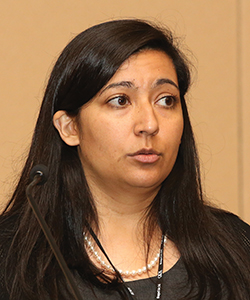
Tara S. Behrend says her research signals that scientists, in order to generate high-quality data from surveys conducted on Amazon Mechanical Turk, need to compensate participants fairly and pay attention to their expectations.
The study involved a group of patients with BPD and a comparison group of people recruited from the community. Across 21 days, all participants used electronic diaries to record their alcohol cravings and consumption in response to random prompts and as part of regularly scheduled reports. They also reported the dates, times, and locations that their cravings and consumption occurred as well as with whom they were interacting.
The data indicated that, compared with the community group, BPD patients drank alcohol more during weekdays compared with weekend days. They also tended to crave and consume more when they were with their romantic partners, coworkers, and children than when they were alone or with anyone else.
Over time, this measurement approach enables researchers to identify the environments and situations that fuel an individual’s substance abuse behaviors, Trull said. He added that this type of research is highly integrative, noting that he works closely with computer scientists and quantitative psychologists.
What To Do With the Data
Once researchers have collected data in real time, they must figure out how best to present the information. This can prove especially challenging when modeling illnesses such as Alzheimer’s disease that have multiple dimensions, said Steve Balsis of Texas A&M University.
Balsis acknowledged that there are many ways to measure multidimensionality, but he presented an approach providing some visual complements that can help with research.
“There are many different indicators — such as the brain, cognition, function, and psychiatric — that exist across many different domains,” Balsis said. “We assess and measure many of these indicators in different ways, so the measurement challenge is more complex than just a unidimensional model to represent this disease process.”
The Ethics of Online Surveying
Modern communications technology is also giving researchers access to vast new pools of research participants. Tara S. Behrend of The George Washington University discussed the responsible use of online samples recruited from communities such as Amazon’s Mechanical Turk (MTurk). MTurk gives researchers access to large subject pools and an accelerated means of collecting data. But some critics argue that MTurk research participants are a smaller and more homogenous group than one might expect, and that they may be wise to common research approaches in ways that can skew their responses. Many MTurk subjects, known as “Turkers,” rely on payments from researchers for their livelihoods and are organizing to achieve fair labor practices and compensation. (Researchers are able to withhold payment if they believe responses are sloppy, fraudulent, or otherwise unusable.)
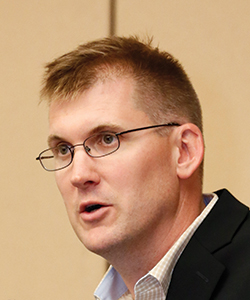
Steve Balsis is pioneering better ways to measure dementia, with a goal of advancing early detection of Alzheimer’s disease.
Behrend presented new findings from a study of Turker behavior to examine how online workers feel about pay and fairness. She and her colleagues Richard Landers, Andrew Collmus, and Elena Auer of Old Dominion University looked specifically at Turkers’ motivation, performance, and satisfaction. The study included 360 people in the first phase (Time 1), with 40% of those individuals returning for a second phase 6 weeks later (Time 2). The participating Turkers took a survey that measured personality traits, skills, decision-making, and demographic characteristics. They were randomly paid 50 cents, $1, or $2 at Time 1 and were promised their payment would increase by 100%, 200%, or 400% at Time 2.
Behrend and her colleagues measured the participants’ effort (i.e., amount of time the participants spent completing the survey and attention paid to the questions) and persistence (i.e., whether they participated in the second phase).
The researchers found that the level of compensation had no effect on the amount of effort participants put forth in responding to the surveys, Behrend reported. But she said she suspects this stems partly from a power dynamic that undercuts the Turkers.
“There’s a really strong perception in this community that their work will be rejected if they don’t spend a certain amount of time on it, and they will receive no pay and have no recourse,” she explained.
People who reported being satisfied with their pay at Time 1 were no more likely to return at Time 2 than were those who expressed dissatisfaction. However, Turkers were most likely to return at Time 2 when they expected the heftiest pay hikes, regardless of their compensation at Time 1. In other words, base compensation was not as much a motivation as was the expected bump in pay.
The findings signal that researchers not only need to fairly compensate the people who participate in their studies and generate high-quality data, but also should pay attention to workers’ expectations, Behrend said.
“What we don’t want to create,” she added, “is an informal economy that isn’t regulated, that doesn’t have any accountability, and where workers are exploited and working for $1 an hour. I think by understanding this community we can optimize it for both workers and researchers.”
References and Further Reading
Balsis, S., Benge, J. F., Lowe, D. A., Geraci, L., & Doody, R. S. (2015). How do scores on the ADAS-Cog, MMSE, and CDR-SOB correspond? The Clinical Neuropsychologist, 29, 1002–1009.
Carroll, K. M., Ball, S. A., Martino, S., Nich, C., Babuscio, T. A., & Rounsaville, B. J. (2009). Enduring effects of a computer-assisted training program for cognitive-behavioral therapy: A 6-month follow-up of CBT4CBT. Drug and Alcohol Dependence, 100, 178–181. doi:10.1016/j.drugalcdep.2008.09.015
Landers, R. N., & Behrend, T. S. (2015). An inconvenient truth: Arbitrary distinctions between organizations, Mechanical Turk, and other convenience samples. Industrial and Organizational Psychology, 8, 142–164.
Lane, S. P., Carpenter, R. W., Sher, K. J., & Trull, T. J. (2016). Alcohol craving and consumption in borderline personality disorder: When, where, and with whom. Clinical Psychological Science. Advance online publication. doi:10.1177/2167702615616132
Linden, D. E. J., Habes, I., Johnston, S. J., Linden, S., Tatineni, R., Subramanian, L., … Goebel, R. (2012). Real-time self-regulation of emotion networks in patients with depression. PLoS One, 7; e38115. doi:10.1371/journal.pone.0038115.





APS regularly opens certain online articles for discussion on our website. Effective February 2021, you must be a logged-in APS member to post comments. By posting a comment, you agree to our Community Guidelines and the display of your profile information, including your name and affiliation. Any opinions, findings, conclusions, or recommendations present in article comments are those of the writers and do not necessarily reflect the views of APS or the article’s author. For more information, please see our Community Guidelines.
Please login with your APS account to comment.